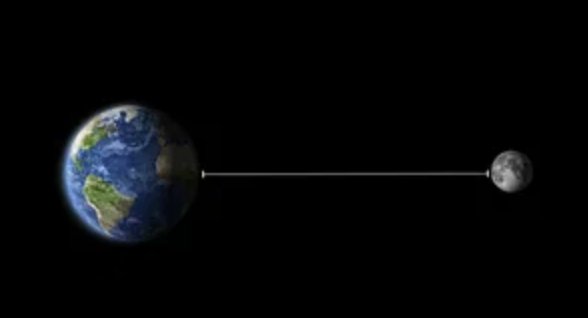How is the distance of the Earth from the Moon measured?
The Moon revolves around the Earth—not in a circular path, but in an elliptical path. Because of this, the distance of the Earth from the Moon is not always the same. Measuring from different places gives different results.

The closest distance from the earth to the moon is 360 thousand kilometers. And the farthest distance is 4 lakh 5 thousand kilometers. But for ease of understanding, the average distance of the Earth from the Moon is assumed to be 3 lakh 84 thousand 400 km. The question is, how do scientists measure this distance?
With the progress of science, scientists have discovered various new methods of measuring this distance. Each technique measures more accurately than the previous one. I will discuss some such methods of distance measurement. Let's start with the modern method.
As such, the first thing to do is to talk about the Lunar Laser Ranging Experiment. Astronauts on the Apollo 11, 14 and 15 missions landed some mirrors on the moon. Light is sent from Earth to a mirror placed on the Moon with the help of a powerful laser. That light is reflected in the mirror and returns back to earth. Scientists calculate how long it takes for laser light to reach the moon and return to earth.
Then the distance of the moon can be determined with the help of simple mathematics. Not only the Apollo missions, but later the Soviet Union's Lunokhad 1 and 2 and India's Chandrayaan-3 missions were similarly fitted with mirrors. This can be calculated by reflecting light on any of them.
Light travels about 3 lakh kilometers per second. Scientists have calculated that it takes a little more than 1 second for the laser light to reach the moon. The same goes for coming back. By calculating from this, scientists found out that the distance from the earth to the moon is 3 lakh 84 thousand kilometers on average. It should be noted here that this measurement was not done by looking at the wristwatch. They have more advanced clocks that can keep track of even the smallest fractions of a second. Even a billionth of a second can be calculated separately with these clocks.The most reliable method of measuring the distance to the Moon is the Lunar Laser Ranging Experiment.
Another such method is distance measurement using radar echoes. Much like a laser ranging experiment. Only sound is sent instead of light. By calculating how long it takes for the echo of that sound to return, scientists determine the distance to the moon in this case. In 1957, the US Naval Research Laboratory broadcast radar pulses to determine the distance to the Moon. They record the echoes from the moon as they return to Earth.But then the noise was so high that scientists did not think it was a reliable calculation.
A year later the experiment was repeated with the help of Royal Radar in England. By solving the previous mistakes, success will be met this time. From the calculation of the return of the echo, scientists said that the distance to the moon is 3 lakh 84 thousand 402 kilometers. Considering the year 1958, think how appropriate the calculation was! As such, there was an error of only ±1.2 km from the current accurate calculation. Yet it was timely enough.
But not only the modern technology, people also determined the distance to the moon long ago. That was more than 2 thousand years ago. At that time, the Greeks determined the distance to the moon with the help of the lunar eclipse. For this, with the help of the circumference of a well, they determined the circumference of the earth. The Greek philosopher Eratosthenes estimated the diameter of the earth to be about 12,874 km. Now we know, this calculation will be 12 thousand 742 km. Isn't it wonderful?
The Greeks calculated that an object 1 inch in diameter could cast a shadow 108 inches long. That is, if you can cast a shadow of only 1 inch of an object 108 inches away from the eye, then you will no longer see sunlight. During a lunar eclipse, sunlight cannot be seen from Earth. It means that the moon covers the sunlight for some time. Scientists know that the diameter of the moon is about 3 thousand 701 kilometers by geometrical method. Now multiply this 108 by 3,701 to get the distance of Earth from the Moon.
Scientists thus found the distance of the moon to be 3 lakh 99 thousand 708 km. Although now we know, the diameter of the moon is actually about 3 thousand 474 km. If they could have calculated the diameter of the moon more accurately then the distance determined might have been a little more accurate. But before that, without technology, this account is - or less.
Thank you, friend!


I'm @steem.history, who is steem witness.
Thank you for witnessvoting for me.
please click it!
(Go to https://steemit.com/~witnesses and type fbslo at the bottom of the page)
The weight is reduced because of the lack of Voting Power. If you vote for me as a witness, you can get my little vote.